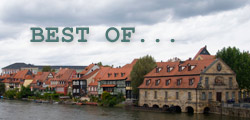Happy New Year, Hogmanay and Auld Lang Syne
 Thursday, January 7, 2010 at 11:56AM
Thursday, January 7, 2010 at 11:56AM We brought in the new year at the home of our new friends, the Pilbeam family and, as usual, we were on the prowl for new customs to help us celebrate. (I was disappointed to find out that Hogmanay, the Scottish New Year celebration, doesn't involve carving turnips.) In fact, when we asked our hosts, Ian and Anne, exactly what Hogmanay means, they admitted the didn't really know the origins -- it's just New Years in Scotland.
Since then, we've been asking more Scots about Hogmanay. I asked at the barbershop and no one knew. We asked our friend, Billy, from Glasgow and he didn't know. We asked at the grocery and the checker didn't know and Brenna asked at her hair dresser and neither woman there knew either. One of them was determined to figure it out though and so of course... Googled it.
The etymology of the word is obscure. It may have been introduced to Middle Scots through the Auld Alliance. In 1604 the custom was mentioned in the Elgin Records as hagmonay. The most satisfactory explanation is a derivation from the Northern French dialect word hoguinané, or variants such as hoginane, hoginono and hoguinettes. Those being derived from 16th century Old French aguillanneuf which is either a gift given at New Year, a children's cry for such a gift or New Year's Eve itself.[1] The second element would appear to be l'an neuf i.e. the New Year. Compare those to Norman hoguinané and the obsolete customs in Jersey of crying ma hodgîngnole, and in Guernsey of asking for an oguinane, for a New Year gift.
Well no-fricken-wonder no one understands the Hogmanay origins. Even Wikipedia doesn't know for sure! The Wiki entry did go on to explain some of the customs though...
The most widespread national custom is the practice of 'first-footing' which starts immediately after midnight. This involves being the first person to cross the threshold of a friend or neighbour and often involves the giving of symbolic gifts such as salt (less common today), coal, shortbread, whisky, and black bun (a rich fruit cake) intended to bring different kinds of luck to the householder. Food and drink (as the gifts) are then given to the guests. This may go on throughout the early hours of the morning and well into the next day (although modern days see people visiting houses well into January). The first-foot is supposed to set the luck for the rest of the year.
Of course there's also the singing of Auld Lang Syne. The traditional Scottish poem was reinterpreted by Robert Burns and later set to music. Do you know all the words? Do you know what they mean? I didn't -- thanks again to Google I found this website. Hope everyone's New Year has been good so far.
 Bob Redpath |
Bob Redpath |  6 Comments |
6 Comments |  Email Article | | in
Email Article | | in  Scotland | tagged
Scotland | tagged  Auld Lang Syne,
Auld Lang Syne,  Hogmanay,
Hogmanay,  New Year,
New Year,  New Years
New Years 













Reader Comments (6)
Should old aquaintence be forgot? It reminds me of the Singing Bee show on cable. That song is an excuse for bad singing the world over. Hope your new years/Hogmanay was great.
I hope you had a great first foot.
Auld Land Syne rocks!!! I love that tune almost as much as a good Al Greene song. Well maybe not that much......Still, fun to sing with a bunch of strangers at midnight.
"We'll take a cup of kindness yet, for Auld Land Syne".
The last stanza of Ald Land Syne should be a anthem for all of us. Maybe that is why we sing it on the eve of a new year. We do need to remind ourselves that kindness to our fellow man should be the predominate act in our lives.
The site you refer us to has all you want to know about Hogmanay!
http://www.hogmanay.net/history/faq#origins
Thank you for sharing this bit of wonder!
Wish we were there!
Big hugs.
Hi Guys!
We check out your site ones in a while and enjoy reading about your experiences and adventures- and of course tell ourselves: "if we were...or if we had.... or if...." we would have loved to travel just like you do!
We wish 2010 will bring you - all that you desire!
All the best, health and happiness,
From,
the Quellers
Rina, Abe, Karen (studying in Italy), Brandi (married and finishing her MBA), Lorit (soon to leave for an extended stay in Israel).